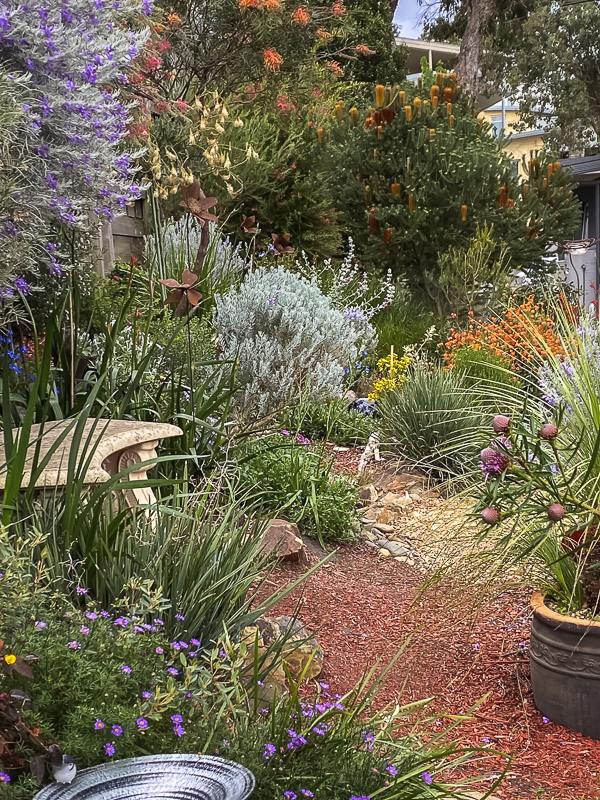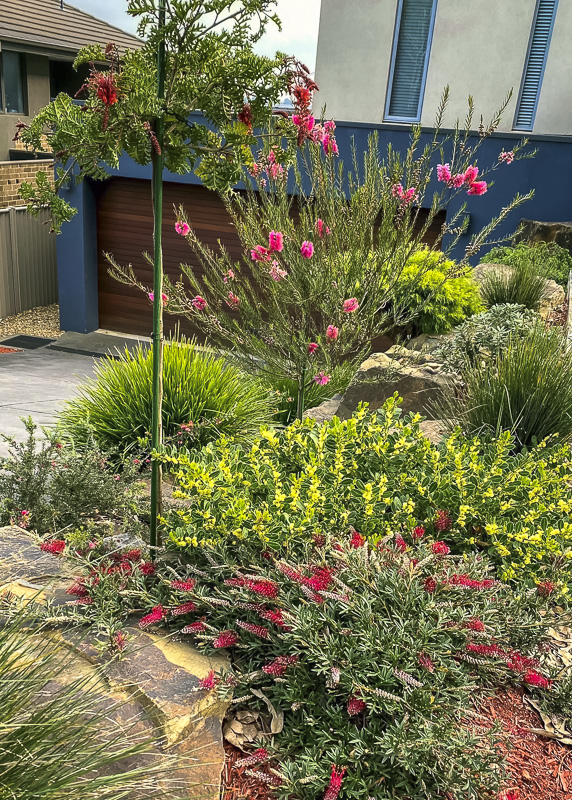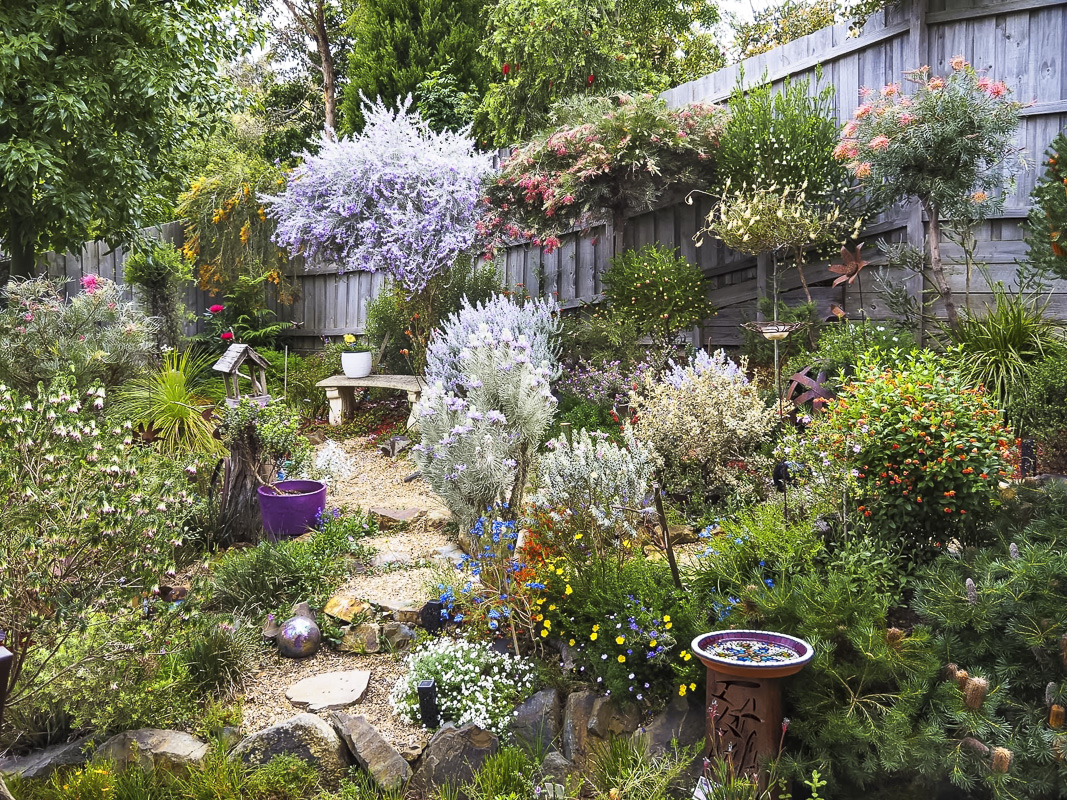Here is a showcase garden, being Deb McMillan’s native garden, Rosella Rise, a habitat and collector’s garden. It is located in Melbourne and was authored by Rae Bassett. It is reproduced wth permission.

Location and climate:
Located in Croydon North, an outer east suburb of Melbourne, Victoria. Temperate climate with warm summer and cold winter.
Site and soil:
A suburban block of around 750sqm with neighbouring houses in close proximity. The back garden is set on a steep slope facing north. The front garden is terraced with large landscaping rocks facing south. The soil is a sandy grey loam with pockets of clay rock.
How long have you been gardening at Rosella Rise?
Around 12 years. When I first moved in the garden had pockets of Agapanthus, succulents, Yuccas, exotic Pittosporum and Kikuyu grass as lawn. Other than these draw backs, I’ve had a relatively blank canvas to work with.


Do you remember the first native plant you bought? What attracted you to it?
Yes, it was a Grevillea ‘Superb’ which I planted outside my dining room window. I used to enjoy sitting inside at the dining room window, admiring the visiting nectar eating native birds. That cemented my love of Australian plants (and wildlife/habitat gardens in general).
How would you describe your garden design style?
My plan was for an all year around colourful, habitat garden, but it has also evolved into a collector’s garden as I have some endangered WA Grevillea species and some normally hard to grow and source plants. I do have lots of colour in flowers and foliage and the garden can sometimes appear as an Australian cottage garden (especially in spring).
What are some surprising successes you’ve had in your garden?
Lechenautia spp. I’m able to successfully grow Lechenautia biloba and L. formosa in the ground, and surprisingly they continue to flower as perennials each year. I also have success growing other WA plants such as Banksia menziesii and Eucalyptus synandra which normally require very specific environmental conditions for them to survive. I believe in experimenting with growing plants, and if one doesn’t survive, I give it a few goes in different positions before I give up. Experimenting with plants helps me to understand my garden’s capability more.
I remember you saying you have a challenging spot in your garden that’s in full shade in winter and hot sun in summer. What native plants would you recommend for that position?
I’ve have been fortunate and had good success with Chorizema cordatum, Correa pulchella, Crowea exalata and low growing forms of Grevillea like G. ‘Cherry Cluster’.


You are well known for using an up-pruning technique to fit more plants in your garden. Can you explain how that works?
Up-pruning is the process of pruning the lower branches from a shrub to encourage one (or more) main trunk(s). This way I can achieve a standard form (or mini tree shape). When I up-prune it allows me to underplant with different colours and textures. I can add understory plants, or garden art, or a bird bath, or a chair to sit and ponder the garden.
For me, up-pruning adds more interest to a garden. I up-prune a plant from a young age or wait until it matures. It all depends on the look I’m are after. For example, on my Grevillea ‘Lollypops’ and G. Superb’. I wanted a straight, single leader trunk. So I needed to assert some influence and stake the plant in early years to keep the main trunk straight. However, more mature plants can be up-pruned too. But their trunks might have some bends and curves in them – this can add to the character too.
(For more on pruning, see our story here.)
What is delighting you the most in the garden this week?
Correa pulchella really shines through a Melbourne winter. Banksia ericifolia and spinulosa are pushing up some beautiful candles. And the low growing, cool tolerant, south eastern Grevilleas are looking a treat. G. ‘Strawberry Smoothie’ is a real winner.
What do you wish you had known when you first started your native garden?
- Not to believe plant label dimensions.
- Also, don’t always accept people’s advice or opinion, get to know your garden environment. If someone says that a plant won’t grow in your area, plant it anyway and see for yourself. Experiment, experiment, experiment!


If you could trade places with one gardener in the world for a week, who would it be and why?
I don’t think that I could pick one gardener, I would need to rotate around four of them. These are all the gardeners that have influenced my gardening style:
- Gill Muller (SA) for her extensive pot collection and clever design skills in small spaces. Gill’s potted garden takes my breath away and her extensive plant knowledge is second to none.
- Carolle Gadd (Gympie, Qld) to learn more about her amazing garden design skills and walk in a Grevillea wonderland.
- Brian & Lorraine Weir (Wallan, VIC) to walk through their wildlife and habitat gardens. Marvel at the collection of grafted standards and learn all about endangered Australian species.
- Bob & Dot O’Neill (Narre Warren Sth, VIC) for the sheer colour array of Australian plants. I am amazed at their Australian plant collection and what can actually be grown in Melbourne.
Rae Basset ‘The Botanical Planet’, thebotanicalplanet.com.au
The author Rae Bassett and Deb McMillan, the garden owner, were pleased to give Lawrie Smith permission to share their article.
Rae said ‘This garden is one of my favourite Australian native gardens. It is a great demonstration of the floral spectacle that can be achieved with our unique flora. Deb’s garden is on a suburban sized block but she packs in a lot of plants.
Using smart plant layering and garden design practices that make the most of every inch, Deb has been able to create an Australian native garden that delivers colour all year round as well as providing abundant nectar and habitat. Rosella Rise is a garden that inspired me when I was beginning my native garden journey. I hope it will inspire you too!’
 Australian Native Plants Society (Australia)
Australian Native Plants Society (Australia)